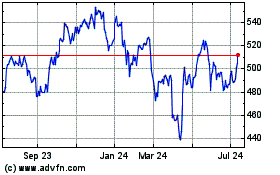Hospitals' Top Priorities Swing to Growth over Costs for 2019
June 12 2019 - 9:00AM
Business Wire
Advisory Board's Annual Health Care Survey
shows executives’ top priorities include improving ambulatory care
access, population health and risk contracting
Hospital and health system executives are shifting their top
strategic focus from cost control to revenue growth, according to
Advisory Board’s Annual Health Care CEO Survey.
For the second time in three years, the No. 1 concern for
hospital executives is improving ambulatory access, meaning
adjusting facilities, staffing, hours of operation or throughput to
increase patients’ ability to receive care across the health
system’s outpatient locations, physician offices and clinics. In
the nationwide survey of 90 C-suite leaders conducted between
January and March 2019, 57 percent of executives said they
were extremely interested in the topic, which rose from eighth
in 2018 and can help health systems increase patient volumes and
revenue.
CEOs, particularly at large health systems, are still seeking
new and effective cost-avoidance measures but see top-line growth
as even more pressing. Two of the top three topics related to
business expansion.
“Health systems have not given up their keen eye on improving
cost control, and yet C-suite executives recognize the need for
comprehensive margin management strategies that include revenue
growth,” said Christopher Kerns, executive director, Research at
Advisory Board. “Balanced strategies are the key to achieving
financial viability and securing the strategic flexibility
necessary to respond to new market entrants and disruptors.”
The survey asked executives about their level of interest for 29
topics, including meeting rising consumer demands for service,
developing a Medicare Advantage strategy and building an effective
innovation hub. The Top 5 areas of extreme interest to hospital and
health system executives are:
1. Improving ambulatory access (57 percent)2.
Minimizing unwarranted clinical variation (53 percent)3.
Strengthening primary care alignment (53 percent)4. Redesigning
health system services for population health (52 percent)5.
Innovative approaches to expense reduction (51 percent)
Minimizing unwarranted clinical variation refers to reducing the
utilization of treatments that do not improve patient outcomes.
Strengthening primary care alignment means improving the
hospital-physician partnership to enable mutual success under
different payment and care-delivery models. Redesigning health
systems for population health refers to making organizational,
facility, process and technology changes to support care and
payment models that promote improvement in patient outcomes rather
than care volume.
“Executives are more interested in moving upstream to capture
revenue growth through ambulatory access and primary care, rather
than traditional strategies of boosting hospital market share,”
said Yulan Egan, practice manager, Research at Advisory Board.
Only one of the Top 5 areas of interest from 2018 ranked among
the Top 5 for 2019: innovative approaches to expense
reduction. Last year’s No. 1 topic, preparing the enterprise
for sustainable cost control, fell to No. 11 out of the 29 topics
included in 2019.
To get an even clearer view into C-suite executives’ priorities,
a separate survey question asked respondents to name their single
top priority among high-level categories. Revenue growth led at 21
percent, followed by population health and Accountable Care
Organization strategy (20 percent). There was a three-way tie for
third at 13 percent among cost containment, physician network
alignment and systemness, which means efforts to streamline
operations, deliver more reliable and coordinated care, rationalize
fixed costs and even transform entire business models. Unlike the
rest of the survey, this question required that respondents choose
only one category. Last year, 24.5 percent of executives chose cost
containment, giving it the 2018 top ranking.
Advisory Board’s membership includes many of the largest and
most progressive hospitals and health systems in the United
States. Survey questions are based on Advisory Board’s more
than 10,000 annual research interviews with health care
executives.
For further insight into the topics of greatest interest to
hospital and health system leaders, visit the Advisory
Board’s At the Helm blog. Health Care Advisory Board
members who could not attend the 2018-19 National Meeting Series
can download the briefing 15 Things CEOs Need to Know in 2019 and
view a webconference series recapping insights on top concerns
for health system C-suite executives.
About Advisory BoardAdvisory Board is a best practices
firm that uses a combination of research, technology, and
consulting to improve the performance of 4,400+ health care
organizations. An Optum business, Advisory Board forges and finds
the best new ideas and proven practices from its network of
thousands of leaders, then customizes and hardwires them into every
level of member organizations, creating enduring value. For more
information, visit www.advisory.com.
Click here to subscribe to Mobile Alerts for UnitedHealth
Group.
View source
version on businesswire.com: https://www.businesswire.com/news/home/20190612005135/en/
Media Contact:Pete SimpkinsonAdvisory
Board202.266.6645SimpkinP@advisory.com
UnitedHealth (NYSE:UNH)
Historical Stock Chart
From Mar 2024 to Apr 2024

UnitedHealth (NYSE:UNH)
Historical Stock Chart
From Apr 2023 to Apr 2024
